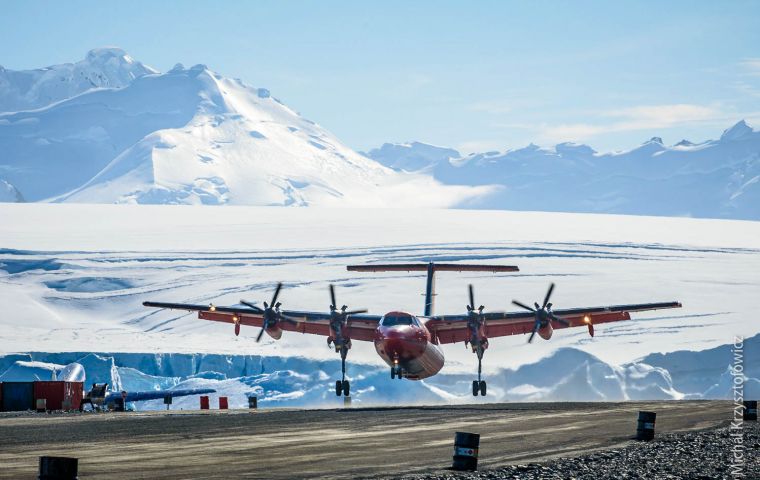MercoPress. South Atlantic News Agency
BAS 2021/22 Antarctic summer field season underway; Rothera/Falklands air link twice a week
 The Dash 7 aircraft is flying from the Falkland Islands to Rothera twice a week, transporting scientists and support staff to the station
The Dash 7 aircraft is flying from the Falkland Islands to Rothera twice a week, transporting scientists and support staff to the station Science and support teams from British Antarctic Survey (BAS) are gearing up for the start of the Antarctic summer field season. All five BAS research stations will be open and undertaking essential science research after a year’s break caused by Covid-19 last season. This will be another challenging season with ongoing Covid-19 protocols to maintain safety for our staff and collaborators.
A large number and variety of science projects will be delivered across a huge geographical area in Antarctica. Projects will address climate science, ecosystems and biodiversity, and test our new autonomous science capability – where scientific instruments collect data without regular input from science or support staff.
Professor Dame Jane Francis, Director of British Antarctic Survey said: “We have a busy and exciting season ahead of us, with some innovative new projects and the imminent arrival of our new polar ship at our research stations. The safety of our staff remains our number one priority and while Covid-19 continues to present us with challenges, teams at BAS have worked hard to ensure our vital research can continue, while keeping Antarctica Covid-free.”
Rothera Research Station
The Dash 7 aircraft is flying from the Falkland Islands to Rothera twice a week, transporting scientists and support staff to the station, following their quarantine period.
Long-term monitoring continues at Rothera this season, with the marine team in the Bonner Laboratory collecting monthly samples of six different species of marine creatures from near the shore around Rothera Point. Data collection for the Rothera Times Series also continues, and weather balloons are released daily, collecting information about the atmosphere above the station. As part of the UK Government’s Blue Belt Program, the dive team will be deploying Baited Remote Underwater Videos, allowing researchers to monitor the animals living in the water near the ocean surface around the station, and learn more about how variation in sea ice, for example, affects these species. Another project will investigate whether the cold Southern Ocean temperatures slow down the growth of marine plants called macro-algae.
Teams will also conduct post-construction monitoring of the environment around the newly-built Rothera wharf, in line with the Protocol on Environmental Protection to the Antarctic Treaty.
On land, research teams will be conducting a survey of terrestrial biodiversity along the Antarctic Peninsula, for the first time using a combination of on-the-ground surveys and satellite images. These datasets will be used to inform evidence-based designation of new Antarctic Specially Protected Areas.
Halley VI
The team arrived at Halley VI in early November. Since their arrival they have been busy powering up the station and equipment.
For the first time since Halley was relocated in the 2016/17 season, researchers there are undertaking two field sampling campaigns. The team will also be installing instruments to collect clean air samples which will be used as a baseline to compare rising methane levels elsewhere in the world.
The team will also continue to monitor the Brunt Ice Shelf. In February 2021, the first of several large icebergs, including the megaberg A74, calved from the ice shelf. Two rifts continue to widen and a network of 17 GPS instruments measure movement of the ice shelf, sending live data to Cambridge every day.
King Edward Point
A new project at King Edward Point will establish long-term whale monitoring in Cumberland Bay East to better understand the distribution and abundance of the increased number of humpback and blue whales observed foraging around South Georgia in recent years.
There will also be ongoing long-term monitoring of plankton communities, and monitoring of the breeding success of fur seals and gentoo penguins.
Bird Island
At Bird Island, the summer science fieldwork is already underway with research projects on fur seals, wandering albatross, molly-hawks, penguins and petrels.
Long-term science projects on Bird Island continue to measure changes in Antarctic ecosystems by monitoring breeding populations of seabirds and seals, and gathering data on population sizes and trends, breeding success and diet.
The team will also be installing equipment to enable automated monitoring of the burrows of white-chinned petrels.
Signy
Signy Research Station is due to be opened on Christmas Day by staff arriving on the RRS Sir David Attenborough.
The Signy team will continue long-term monitoring and surveys on marine predators, including seals, penguins and flying seabirds. These are valuable indicators of the health of the Antarctic ecosystem. The team will also collect bivalve mollusks called Lissarca miliaris – small, shelled creatures that live on the red and brown seaweed around Signy. The bivalves are collected to monitor how sea temperature changes size and breeding patterns.
International Thwaites Glacier Collaboration
This summer is the third of four field seasons for ITGC, with UK and US scientists collaborating to investigate one of the most unstable glaciers in Antarctica, the Thwaites Glacier. Four of the eight research projects will be deployed this year. The team at Thwaites received a successful air drop of vital supplies, and the tractor and traverse team is about to start moving again after the traverse equipment spent the winter at Sky Blu Field Station
Twenty-four scientists and technicians will join the Nathanial B Palmer, the US polar vessel, for a research cruise for the TARSAN and THOR projects. The teams will (among other things) undertake oceanographic surveys beneath the Thwaites Ice Shelf, deploy ocean gliders and survey the seabed using sonar systems.




Top Comments
Disclaimer & comment rulesCommenting for this story is now closed.
If you have a Facebook account, become a fan and comment on our Facebook Page!